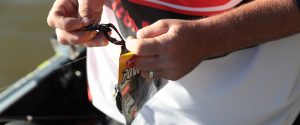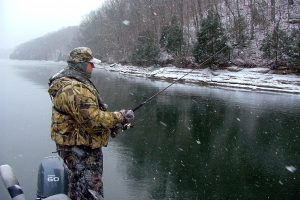Courtesy Of Berkley
Many bass fans stash their tackle in cold storage during the winter, but Berkley pro Josh Bertrand isn’t one of them. The savvy western angler knows the coldwater period offers ample opportunities to catch largemouths, spots and smallies. In fact, he says that firing up a school of burly winter bass can spark incredibly fast action.
“I love to fish and would rather be on the water than watching football, hunting, or doing anything else, so there’s no way I’m sitting out bass fishing for the winter,” he says. “But it’s not a fruitless pursuit, either. Bass still eat. They hang out in predictable places. And when you hit a mother lode of schoolies, you can enjoy an absolutely amazing day on the water.”
To tap the winter bite, Bertrand targets high-percentage areas with a handful of pet patterns. The strategies hold water on his home lakes in Arizona, but can also help you catch more bass this winter on lakes across the country.
Setting The Stage
Before we delve into tactics, let’s explore the world of the winter bass. “The fish aren’t thinking about spawning and they’re not very active,” Bertrand begins.
“They’re looking for a comfortable place to hang out that offers stable conditions and an opportunity to feed when they need to,” he continues. “Because bass metabolism slows way down in cool water, they might only require a meal once or twice a day. In really cool water, they may only feed once every couple of days.”
Bertrand says ideal winter bass habitat often includes deep water, either in the form of fertile flats or channel edges where bass can move up and down the breakline to feed.
“In the lakes I fish out West, deep creek channels and flats in 30 to 40 feet of water hold bass,” he explains. “In shallower systems elsewhere in the country, the fish might relate to the deepest bank, channel or other drop-off they can find.”
Regardless of the zip code, Bertrand says rocks or woody cover sweetens the structural pot. “Rocks hold food and heat,” he says. “And deep, flooded trees or brush can also be bass magnets.”
Baitfish are also a factor, he notes. “Bass are going to be where the bait is,” he says. “Shad are a common forage species in many lakes. Because they’re fragile and can’t handle cold water, they tend to favor these same types of areas. When the water is 44 degrees, you’re not going to find shad in two feet of water in a creek arm.”
Football Fever

Bertrand would much rather drag a football head for winter bass than watch football on TV, and says the deadly jigging approach is a time-tested means of putting coldwater bass in the boat.
“It’s definitely an old reliable tactic you can use just about anywhere you find bass,” he says.
To get started, he locates a bassy-looking area like the end of a steep rock bluff or channel swing, and reaches for a 7½-foot, medium-heavy casting outfit spooled with 15-pound-test Berkley Trilene 100 Percent Fluorocarbon.
Why Use Fluoro
He ties a ½- to ¾-ounce football-style jighead direct to the mainline, and threads a 4-inch, green pumpkin-pattern Berkley

PowerBait Chigger Craw on the hook. “Football heads are great on rocky bottoms because they rock and roll over cracks and crevices, without falling in and snagging like other types of jigs,” he says. “A PowerBait trailer is key because its scent encourages bass to hang onto the bait long enough for me to feel the bite and make the hookset.”
Rigged and ready, Bertrand fires out a long cast and lets the jig fall to bottom on slack line, then begins a slow, crawling retrieve. “Use the rod tip to slowly move the jig an inch at a time,” he says. “If you think you might be going too slow—slow down a little more.”
Strikes are soft and often register merely as “mushy” feelings on the end of the line. “Hooksets are free and there’s no limit, so set the hook anytime you feel something different,” he advises.
Jerkbait Blitz
Slim-profile, hard-bodied jerkbaits also excel during the big chill. “They’re great search baits,” says Bertrand, who favors suspending models with a decent-sized profile, like the 4 3/8-inch Berkley Cutter 110+ in shades of Chartreuse Shad or Chameleon Vapor. “It gives bass a shot at a meal worth eating, yet can be suspended for extended periods to allow sluggish fish to swim over and take the bait.”
Bertrand explains that jerkbaits mimic the death throes of an expiring shad. “Dying shad hang motionless, twitch a little, pause and sink, then twitch again,” he says. “Fished in a twitch-pause-twitch cadence with a little slack in your line to foster erratic lure movement, jerkbaits imitate this performance perfectly.”
